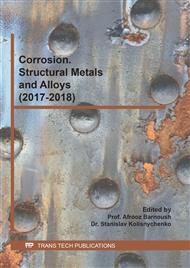[1]
J. Royset, N. Ryum, Scandium in aluminium alloys, Int. Mater Rev. 50(1) (2005) 19-44.
Google Scholar
[2]
B. Forbord, W. Lefebvre, F. Danoix, H. Hallem, K. Marthinsen, Three dimensional atom probe investigation on the formation of Al-3(Sc, Zr)-dispersoids in aluminium alloys, Scripta Mater. 51(4) (2004) 333-337.
DOI: 10.1016/j.scriptamat.2004.03.033
Google Scholar
[3]
Y. Shi, Q. Pan, M. Li, X. Huang, B. Li, Effect of Sc and Zr additions on corrosion behaviour of Al-Zn-Mg-Cu alloys, J Alloy Compd. 612 (2014) 42-50.
DOI: 10.1016/j.jallcom.2014.05.128
Google Scholar
[4]
Y. Deng, Z. Yin, K. Zhao, J. Duan, J. Hu, Z. He, Effects of Sc and Zr microalloying additions and aging time at 120 degrees C on the corrosion behaviour of an Al-Zn-Mg alloy, Corros Sci. 65 (2012) 288-298.
DOI: 10.1016/j.corsci.2012.08.024
Google Scholar
[5]
M.B. Kannan, V.S. Raja, Influence of heat treatment and scandium addition on the electrochemical polarization behavior of Al-Zn-Mg-Cu-Zr alloy, Metall Mater Trans A. 38A(11) (2007) 2843-2852.
DOI: 10.1007/s11661-007-9303-6
Google Scholar
[6]
J. Wloka, S. Virtanen, Influence of scandium on the pitting behaviour of Al-Zn-Mg-Cu alloys, Acta Materialia. 55(19) (2007) 6666-6672.
DOI: 10.1016/j.actamat.2007.08.021
Google Scholar
[7]
D.K. Ryabov, N.I. Kolobnev, S.V. Samohvalov, Effect of scandium addition on mechanical properties and corrosion resistance of medium strength Al-Zn-Mg(-Cu) alloy, in: K. Marthinsen, B. Holmedal, Y. Li (Eds. ) Aluminium Alloys 2014-ICAA14. 2014, pp.241-246.
DOI: 10.4028/www.scientific.net/msf.794-796.241
Google Scholar
[8]
Z.M. Li, H.C. Jiang, Y. L. Wang, D. Zhang, D.S. Yan, L.J. Rong, Effect of minor Sc addition on microstructure and stress corrosion cracking behavior of medium strength Al-Zn-Mg alloy, submitted to J. Mater. Sci. Technol. (2017).
DOI: 10.1016/j.jmst.2017.11.042
Google Scholar
[9]
ASTM G31-12a. ASTM International. Standard Guide for Laboratory Immersion Corrosion Testing of Metals.
Google Scholar
[10]
T. Ramgopal, P.I. Gouma, G.S. Frankel, Role of grain-boundary precipitates and solute-depleted zone on the intergranular corrosion of aluminum alloy 7150, Corrosion. 58(8) (2002) 687-697.
DOI: 10.5006/1.3287699
Google Scholar
[11]
GB 7998-2005. National standard of China. Test method for inter-granular corrosion of aluminum alloys.
Google Scholar
[12]
GB/T 22639-2008. National standard of China. Test method of exfoliation corrosion for wrought aluminum and aluminum alloys.
Google Scholar
[13]
Z. Ahmad, A. Ul-Hamid, A.A. B. J, The corrosion behavior of scandium alloyed Al 5052 in neutral sodium chloride solution, Corros Sci. 43(7) (2001) 1227-1243.
DOI: 10.1016/s0010-938x(00)00147-5
Google Scholar
[14]
R.K. Gupta, A. Deschamps, M.K. Cavanaugh, S.P. Lynch, N. Birbilisa, Relating the Early Evolution of Microstructure with the Electrochemical Response and Mechanical Performance of a Cu-Rich and Cu-Lean 7xxx Aluminum Alloy, J Electrochem Soc. 159(11) (2012).
DOI: 10.1149/2.062211jes
Google Scholar
[15]
M.J. Robinson, N.C. Jackson, The influence of grain structure and intergranular corrosion rate on exfoliation and stress corrosion crackingof high strength Al-Cu-Mg alloys, Corros Sci. 41 (1999) 1013-1028.
DOI: 10.1016/s0010-938x(98)00171-1
Google Scholar
[16]
K.D. Ralston, D. Fabijanic, N. Birbilis, Effect of grain size on corrosion of high purity aluminum, Electrochem Acta. 56 (2011) 1729-1736.
DOI: 10.1016/j.electacta.2010.09.023
Google Scholar



